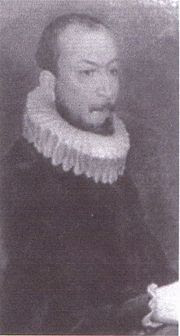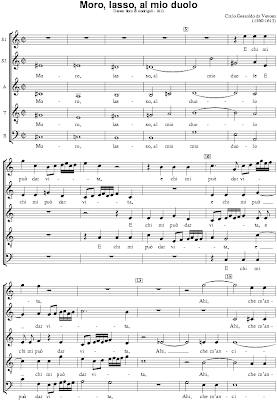
Carlo Gesualdo (Gesualdo da Venosa, c. March 8, 1566, Venosa - c. September 8, 1613),

Prince of Venosa

[in the Vulture area of

Basilicata] and

Count of Conza

[in the adjacent Campania], was part of an aristocratic family which acquired the principality of Venosa in 1560, the year which has been alternately cited as that of the composer's birth.
His rather righteous family included uncle Carlo Borromeo (later sainted -- what a contrast!), and mother Girolama, niece of Pope Pius IV and writer of a letter, recently discovered, that implies the above birth year.
Gesualdo had a musical relationship with Pomponio Nenna, and a single-minded devotion to music from an early age, as performer on lute, guitar, and harpsichord.
The composer married his first cousin, Donna Maria d'Avalos, the daughter of the Marquis of Pescara, in 1586. Two years later she began to have a love affair with Fabrizio Carafa, the Duke of Andria, keeping it secret from her somewhat clueless husband for almost almost another two years, even though the relationship was known elsewhere.
On October 16, 1590, at the Palazzo San Severo in Naples, when Gesualdo had allegedly gone away on a hunting trip, the two lovers took insufficient precaution (Gesualdo had arranged with his servants to have the locks of his palace copied in wood so that he could gain entrance if locked), and he returned to the palace, caught them in flagrante delicto and brutally murdered them both in their bed; afterwards he left their mutilated bodies in front of the palace for all to see. Being a nobleman he was immune to prosecution, but not to revenge, so he fled to his castle at Gesualdo where he would be safe from any of the relatives of either his wife or her lover.
Details on the murders are extant, from the depositions of magistrate's witnesses which have survived in full. While Gesualdo apparently had help from his servants in the actual double slaying, he himself stabbed Maria multiple times, shouting in the act Monty Pythonestically "she's not dead yet!" The Duke of Andria was found with numerous deep sword wounds, shot through the head, dressed in Maria's night dress, with his own unbloodied clothing piled up by the bedside.
The murders were widely publicized, including in verse by Tasso and a flock of salacious, sensationalist Neapolitan poets. The police report rom the scene makes for shocking reading even after more than 400 years.
According to some contemporary sources, Gesualdo also murdered his infant second son by Maria. After looking into his eyes and doubting his paternity, he "swung the infant around in his cradle until the breath left his body." Another source indicates that he additionally murdered his revenge-seeking father-in-law. Gesualdo had employed a company of men-at-arms to ward off such an event.
In 1594, Gesualdo went to Ferrara, a hub of artistic activity and home to progressive madrigalist Luzzasco Luzzaschi and the Estes. There the manic-depressive, music-obsessed murderer married Leonora d'Este (niece of Duke Alfonso II), and enjoyed an atmosphere of avant-garde creative activity, surrounded by some of the finest musicians in Italy.
In a letter of June 25, 1594 Gesualdo wrote that he was writing music for three women in the concerto delle donne, and some manuscript work probably from this period implies that he was already experimenting with the new monadic trend of the day as well as his own crazy brand of chromaticism.
He published his first books of five-voice madrigals, initially close in style to that of his contemporaries, from 1594-1596, in Ferrara.
Book I (Madrigali libro primo), five voices, Ferrara, 1594
Book II (Madrigili libro secondo), five voices, Ferrara, 1594
Book III (Madrigali libro terzo), five voices, Ferrara, 1595
Book IV (Madrigali libro quarto), five voices, Ferrara, 1596
After resettling with his wife to his castle at Gesualdo in 1597, he attempted to set up a similar situation to that which existed in Ferrara, with a group of resident, virtuoso musicians who would sing his own music. But, while his estate became a center of music-making, it was for Gesualdo alone, and with his considerable financial resources, he was able to hire singers and instrumentalists for his own pleasure. But he was a solitary man by nature and his estate never became a cultural center the way the Este estate at Ferrara did.
From around 1599 until his death, he hardly ever left his castle.
Surprise, surprise -- his new wife accused him of abuse, and the Este family tried to get her a divorce. She spent more and more time away from Gesualdo's isolated estate, and he wrote many angry letters to Modena where she often went to stay with her brother. At least she apparently stayed alive. As Cecil Gray notes , "She seems to have been a very virtuous lady ... for there is no record of his having killed her."
In 1600, his son by his second marriage died, and after this Gesualdo had a large painting commissioned for the local church of the Capuchins, which shows the composer, his uncle Carlo, wife Leonora, and dead son underneath a group of angelic figures.
Most of music, including his often wildly chromatic and difficult madrigals, were published in 1603 and 1611, falling into three categories: sacred vocal music, secular vocal music, and instrumental music.
Book V (Madrigali libro quinto), five voices, Gesualdo, 1611
Book VI (Madrigali libro sesto), five voices, Gesualdo, 1611
One of the most obvious characteristics of his music is the extravagant text setting of words representing extremes of emotion: "agony," "death," "ecstacy," "love," "pain," and so on, occur frequently in his madrigal texts, most of which he probably wrote. While common among late 1500's and early 1600's madrigalists, word-painting reached an extreme with Gesualdo.
Experiments with harmonic progression, cross-relation and violent rhythmic contrast increase in these later books, containing the most famous and extreme examples, such as Moro, lasso, al mio duolo and Beltà, poi che t'assenti both of which are in Book VI. There is evidence that Gesualdo had these works in score form, in order to better display his contrapuntal inventions to other musicians, and also that Gesualdo intended his works to be sung by equal voices, as opposed to the concerted madrigal style popular in the period, which involved doubling and replacing voices with instruments.
Characteristic of the composer's style is a sectional format in which relatively slow-tempo passages of wild, occasionally-shocking chromaticism alternate with quick-tempo diatonic passages. The text is closely wedded to the music, with individual words being given maximum attention. Some of the chromatic passages are twelve note within a single phrase, although scattered throughout different voices. Gesualdo was particularly fond of chromatic third relations, for instance juxtaposing the chords of A major and F major, or even C-sharp major and A minor, as he does at the beginning of Moro lasso al mio duolo.

C# Am/C B . . . E Am
III i6 II . . . V i
Moro, lasso, al mio duolo,
E chi può dar mi vita,
Ahi, che m'ancide e non vuol darmi aita!
O dolorosa sorte,
Chi dar vita mi può,
Ahi, mi dà morte!
I die, alas, in my suffering,
And she who could give me life,
Alas, kills me and will not help me.
O sorrowful fate,
She who could give me life,
Alas, gives me death.
His most famous sacred composition is the set of Tenebrae Responsoria (Tenebrae Responsories, using texts from the Passion, specificaly those relating to Maundy Thursday, the evening of the Last Supper and Trial), also published in 1611, which are stylistically madrigali spirituali — madrigals on sacred texts. As in the later books of madrigals, he uses particularly sharp dissonance and shocking chromatic juxtapositions, especially in the parts highlighting text passages having to do with Christ's suffering, or the guilt of St. Peter in having betrayed Jesus.
Late in life Gesualdo also suffered, but from depression -- not surprisingly evidently over the guilt of the multiple murders. A certain Campanella, writing in Lyon in 1635, avered that Gesualdo had himself beaten daily by his servants, and he kept a special assistant to beat him "at stool." Toward the end he engaged in a relentless, fruitless, correspondence with to obtain relics -- skeletal remains,of his now late sainted uncle Carlo, with which he hoped to obtain healing for mental disorder, and possibly absolution for his crimes.
His late setting of Psalm 51, Miserere, is distinguished by its insistent and imploring musical repetitions, alternating lines of monophonic chant with pungently chromatic polyphony in a low vocal tessitura.
Gesualdo died in isolation, at his castle Gesualdo in Avellino, three weeks after the death of his son Emanuele, his first son by his marriage to Maria. One 20th-century biographer has suggested that, in a what-goes-around-comes-around spririt, he may have been murdered by his second wife.
He was buried in the chapel of Saint Ignatius, in the church of the Gesù Nuovo, in Naples. Even in death he was not ultimately "at rest: for, the sepulchre was destroyed in the earthquake of 1688 (more punishment?), and, when the church was rebuilt, the tomb was covered over, now under the pavement of the church. Gesualdo's burial plaque, however, remains visible.
Gesualdo had little influence at the time, although a few composers such as Sigismondo d'India and Antonio Cifra wrote a handful of works in imitation of his madrigalian style; it was only in the 20th century that he was rediscovered.
The life of Gesualdo provided inspiration for numerous works of fiction and music drama, including a novel by Anatole France, a short story by Julio Cortazar, and an opera by Franz Hummel.
Igor Stravinsky arranged Gesualdo's madrigal Beltà, poi che t'assenti as part of his Monumentum pro Gesualdo (1960), Alfred Schnittke wrote an opera in 1995 based on his life, and Salvatore Sciarrino has arranged several madrigals for an instrumental ensemble.
In 1997, the Australian composer Brett Dean paid homage to Gesualdo in Carlo -- an intense and affecting work for string orchestra, tape and sampler.
While other composers at the end of the 16th and beginning of the 17th Centuries wrote experimental music, Gesualdo's creation was unique and isolated, without heirs or followers, a fascinating temporary dead-end in musical history, and an analogue to his personal isolation as an heirless prince, ruined by guilt.
[8567 Monteverdi / Gesualdo 8566 / 8563 Dowland]
